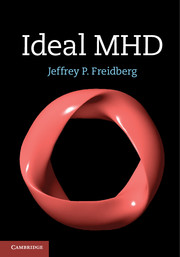Book contents
- Frontmatter
- Dedication
- Contents
- Preface
- Acknowledgements
- 1 Introduction
- 2 The ideal MHD model
- 3 General properties of ideal MHD
- 4 MHD equilibrium: general considerations
- 5 Equilibrium: one-dimensional configurations
- 6 Equilibrium: two-dimensional configurations
- 7 Equilibrium: three-dimensional configurations
- 8 MHD stability – general considerations
- 9 Alternate MHD models
- 10 MHD stability comparison theorems
- 11 Stability: one-dimensional configurations
- 12 Stability: multi-dimensional configurations
- Appendix A Heuristic derivation of the kinetic equation
- Appendix B The Braginskii transport coefficients
- Appendix C Time derivatives in moving plasmas
- Appendix D The curvature vector
- Appendix E Overlap limit of the high β and Greene–Johnson stellarator models
- Appendix F General form for q(ψ)
- Appendix G Natural boundary conditions
- Appendix H Upper and lower bounds on δQKIN
- Index
- References
6 - Equilibrium: two-dimensional configurations
Published online by Cambridge University Press: 05 July 2014
- Frontmatter
- Dedication
- Contents
- Preface
- Acknowledgements
- 1 Introduction
- 2 The ideal MHD model
- 3 General properties of ideal MHD
- 4 MHD equilibrium: general considerations
- 5 Equilibrium: one-dimensional configurations
- 6 Equilibrium: two-dimensional configurations
- 7 Equilibrium: three-dimensional configurations
- 8 MHD stability – general considerations
- 9 Alternate MHD models
- 10 MHD stability comparison theorems
- 11 Stability: one-dimensional configurations
- 12 Stability: multi-dimensional configurations
- Appendix A Heuristic derivation of the kinetic equation
- Appendix B The Braginskii transport coefficients
- Appendix C Time derivatives in moving plasmas
- Appendix D The curvature vector
- Appendix E Overlap limit of the high β and Greene–Johnson stellarator models
- Appendix F General form for q(ψ)
- Appendix G Natural boundary conditions
- Appendix H Upper and lower bounds on δQKIN
- Index
- References
Summary
Introduction
In Chapter 5 it was shown that a one-dimensional, cylindrically symmetric magnetic geometry accurately describes radial pressure balance in many fusion configurations. The primary goal of Chapter 6 is to address the problem of toroidal force balance in a two-dimensional axisymmetric toroidal geometry. A secondary goal analyzes straight systems with two-dimensional helical symmetry.
The discussion starts with a derivation of the Grad–Shafranov equation, the basic equation describing axisymmetric toroidal equilibrium. For configurations possessing such symmetry, the solutions to this equation provide a complete description of ideal MHD equilibria: radial pressure balance, toroidal force balance, equilibrium β limits, rotational transform, and kink safety factor. A wide number of configurations are well described by the Grad–Shafranov equation. Included among them are all types of tokamaks, the reversed field pinch, the levitated dipole, the spheromak, and the field reversed configuration.
- Type
- Chapter
- Information
- Ideal MHD , pp. 123 - 222Publisher: Cambridge University PressPrint publication year: 2014



